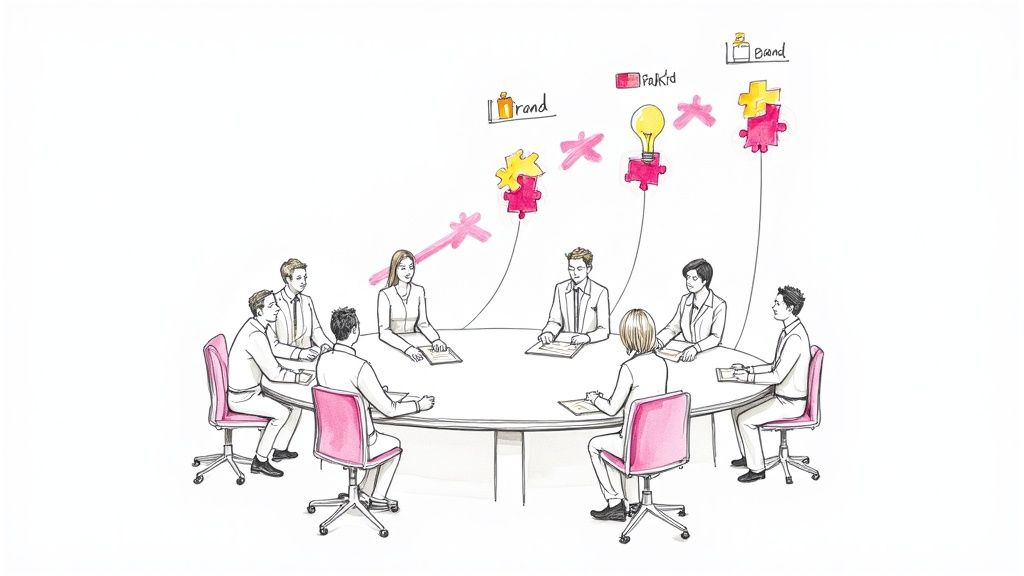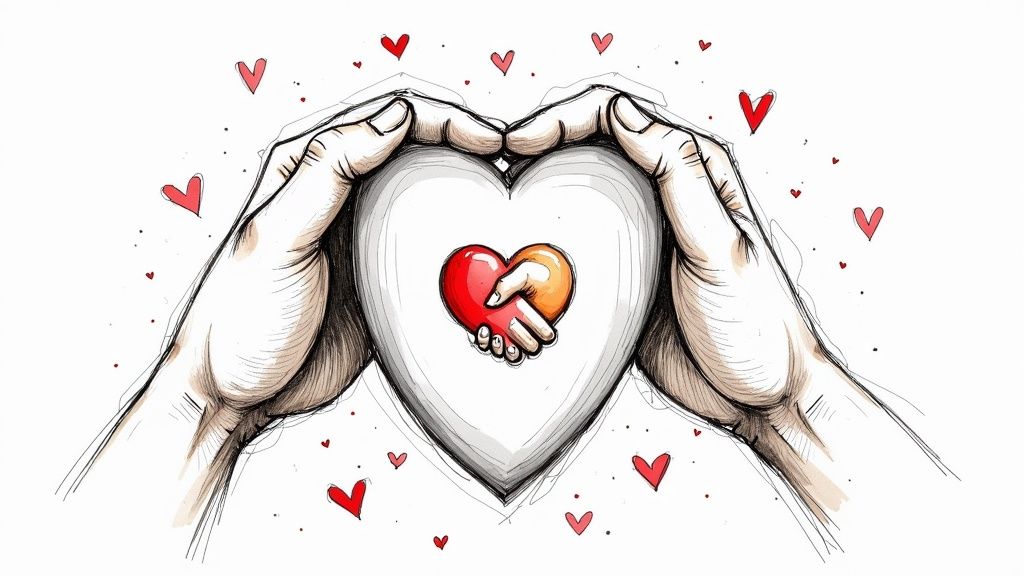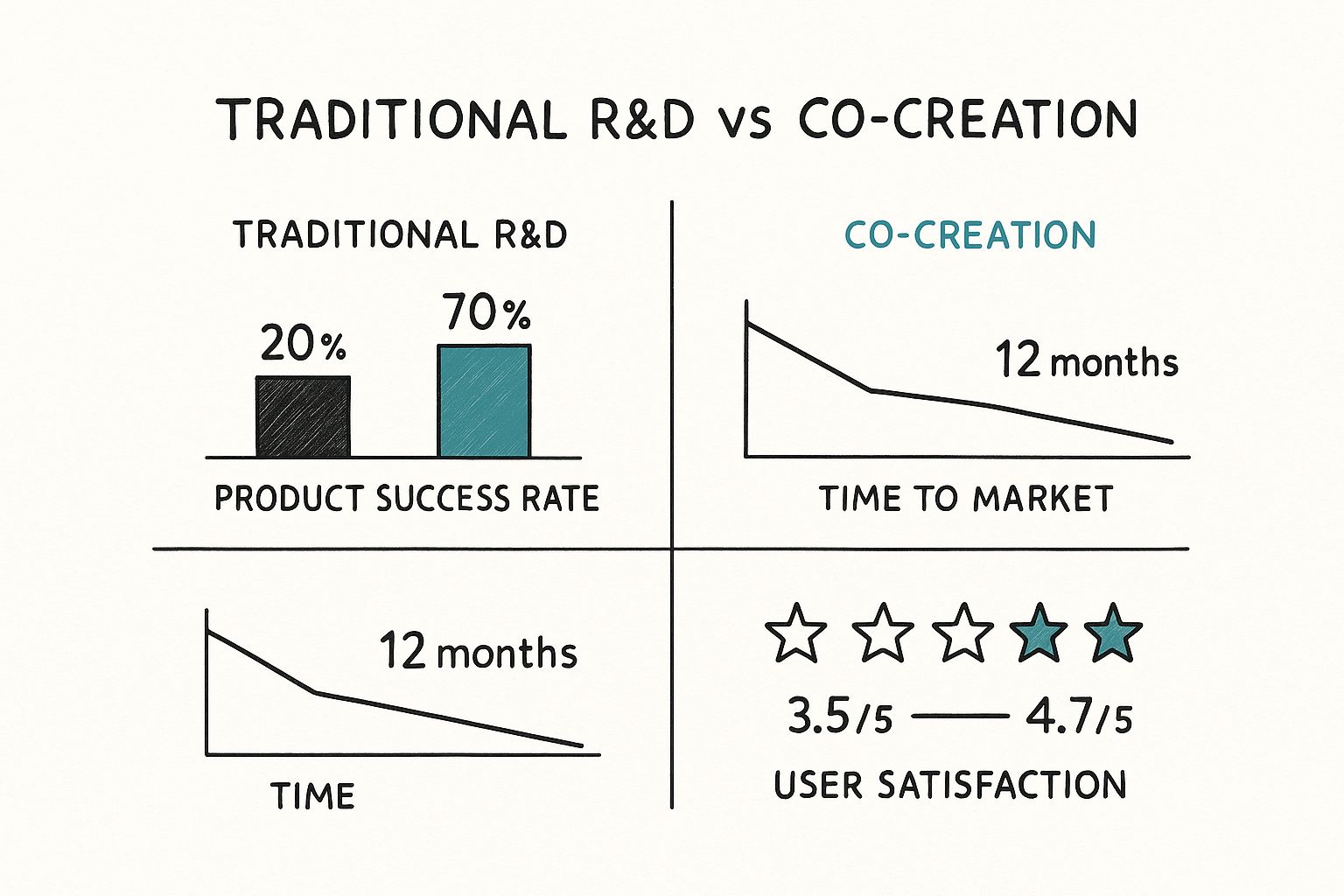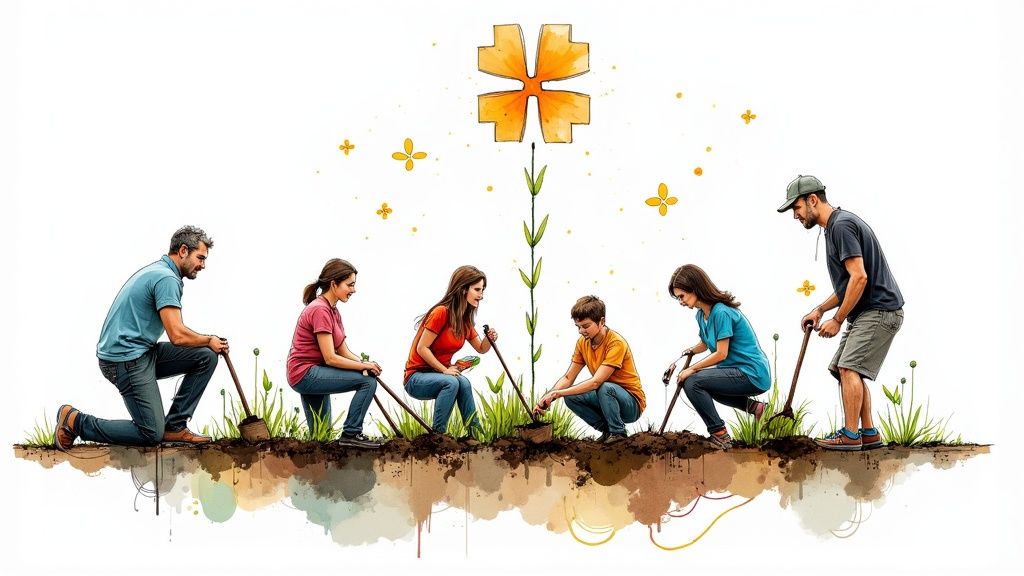October 18, 2025

At its heart, community engagement is about creating fierce brand loyalty, uncovering invaluable customer insights that drive product innovation, and sparking sustainable, long-term growth. It's the difference between having a passive audience and building a tribe of active partners who will champion and co-create with your brand.

Let's cut through the noise. A genuine community isn't about vanity metrics on social media; it’s a strategic asset that can power your entire organization. The real magic happens when you create a two-way street where you stop talking at your people and start building with them.
Think of it less like a megaphone and more like a roundtable. This shift is grounded in three simple but powerful actions: listening, collaborating, and empowering. When you get this right, you unlock tangible business results that standalone marketing campaigns just can't touch.
The first step is a mental one. An audience just consumes what you put out. A community, on the other hand, contributes. That distinction is everything, because an engaged community becomes a serious competitive advantage, delivering real outcomes that push your mission forward.
Here’s what that shift unlocks:
A well-run community strategy transforms your customer base from a static contact list into a powerful, self-sustaining ecosystem that fuels both growth and resilience.
To build a space where people genuinely want to connect, it's crucial to understand the proven strategies for building impactful online communities. This foundation ensures your work leads to real relationships, not just surface-level interactions.
Turning this vision into a reality takes a clear plan. For a complete walkthrough on getting started, check out our guide on https://groupos.com/blog/how-to-build-online-community from scratch.

One of the most powerful things a community does is turn passive customers into passionate advocates. It’s the difference between someone who just buys from you and someone who feels like they belong with you. Marketing campaigns can get you a sale, but genuine, consistent interaction builds a kind of loyalty you simply can't buy.
This all comes down to basic human psychology. When people feel seen, heard, and valued, they form a real emotional connection. This goes way beyond good customer service; it’s about creating a shared identity where members feel like they’re part of something bigger.
Think about your customer base shifting from a transactional marketplace into a full-blown fan club. In a fan club, members don't just consume—they contribute, defend, and promote your brand on their own. They become your most credible marketers because their support comes from a place of genuine, positive experience.
This shift doesn't happen by accident. It’s built through consistent, value-driven interactions. Stop just broadcasting announcements and start facilitating real conversations. When you give members a space to connect with each other and your team, you tap into a powerful network effect that grows on its own.
Building a community is about investing in people, not just personas. This investment creates a deep well of goodwill that translates into measurable business outcomes, including higher retention rates and increased customer lifetime value.
If you're looking to deepen these connections, you need the right tactics. We've put together a resource with proven member engagement strategies in our detailed guide that offers actionable steps for fostering these kinds of loyalty-building interactions.
A strong community is also the best insurance policy you can have when things go wrong. Inevitably, challenges will pop up—a product issue, a service outage, or a public relations misstep. A loyal community gives you a critical buffer. Because you’ve already built a foundation of trust, your members are far more likely to give you the benefit of the doubt.
Instead of weathering a storm of public criticism alone, you have a group of advocates who understand your brand's heart and intentions. Being transparent with your community during a crisis can quickly turn a negative situation around. This bedrock of trust is incredibly difficult for competitors to replicate.
The long-term ROI of investing in these human connections is a resilient, unshakeable brand. And with a platform like GroupOS, you can centralize these crucial conversations, ensuring your communication is clear, direct, and effective when it matters most.
Stop guessing what your customers want and start building it with them. This is one of the most powerful outcomes of a strong community engagement strategy—it completely changes how you innovate. When you treat your community like your most valuable research and development partner, you can finally move past the guesswork and start co-creating solutions you know people will love.
This shift is all about co-creation, where customers are no longer just passive consumers but active collaborators in your brand's journey. They give you a direct pipeline to raw, unfiltered feedback, helping you pinpoint unmet needs and validate new ideas before sinking a ton of money into development. This partnership approach takes a lot of the risk out of product development and helps you get to market faster.
Tapping into your community's collective brainpower can look a few different ways. You could run an exclusive beta program for your most dedicated members, giving them a sneak peek at new features in exchange for their honest thoughts. Or, you can just pay attention to the organic conversations happening in your forums to see what problems people are trying to solve and what they’re asking for.
Here are a few practical ways to do it:
By building with your community instead of just for them, you ensure there is a market waiting for your product before it even launches. It's a strategic shift from "build it and they will come" to "let's build it together."
This collaborative approach is especially powerful in professional spaces where expertise is shared. You can see this in action by exploring these insightful community of practice examples.
When you contrast traditional market research with the insights you get from an engaged community, the differences are night and day. Old-school methods are often slow, expensive, and can feel a bit sterile. Community feedback, on the other hand, is fast, continuous, and authentic.
The takeaway is clear: while traditional research still has its place, nothing beats the continuous, high-quality insights that come directly from the people who use your product every day.
The infographic below really drives home the difference in outcomes.

As you can see, bringing your community into the fold leads to a much higher product success rate, faster delivery, and a huge boost in user satisfaction.
With GroupOS, you have the tools to make this happen seamlessly. You can create private channels for beta testers, run quick polls to gauge interest in new ideas, and host forums where your next big product breakthrough can emerge naturally. It turns your community into a sustainable engine for innovation.

The impact of community engagement goes way beyond business goals, creating real, tangible improvements in public health and social well-being. When people get a say in the wellness, safety, and education programs in their own backyards, the results are simply better and more likely to last. It’s a shift away from top-down directives toward empowering people to build healthier lives for themselves.
This isn’t just a feel-good idea; it’s a proven model for creating stronger, more resilient societies. People who have a genuine stake in the outcome are naturally more invested. This deep involvement builds stronger social connections and, ultimately, better health for everyone. The magic happens when you stop treating people as passive recipients and start seeing them as active partners in change.
Wondering if this actually works in the long run? Absolutely. One of the most compelling examples is the Stanford Three Community Study, which started all the way back in 1972. The study found that cities with active health education and community participation saw dramatically better health outcomes than a control city.
This research became a cornerstone for public health programs around the world. It proved that getting the community involved isn't just a nice-to-have—it’s a powerful driver of measurable, lasting health improvements that can span decades.
When people co-design health initiatives, they are not just following instructions—they are leading a movement. This sense of ownership is the catalyst for sustainable public health advancements.
The same principles that create great brands—listening, empowering, and building a shared purpose—are exactly what you need to improve public health. For any organization working for the social good, these aren't optional.
Here’s what that looks like in practice:
Putting these ideas into motion takes the right strategy. For a closer look at the specific tactics that drive this kind of positive change, check out these community engagement strategies in our dedicated guide.
With a platform like GroupOS, nonprofits and public health groups can build a central hub to organize volunteers, share educational content, and spark the conversations that lead to healthier communities for everyone.
When community engagement is done right, it’s about more than just brand loyalty. It becomes a genuine engine for social change. It’s about creating spaces where everyone feels seen, heard, and valued—giving a voice to people who are too often overlooked. This is especially true for marginalized groups, where real participation builds social capital and creates a true sense of inclusion.
This isn't about top-down directives. It’s about giving individuals a real stake in their own collective future. When you invite people to help design the solutions to the problems they face every day, they transform from passive recipients into active partners. That feeling of ownership is the bedrock of any lasting social progress.
We have to be honest about the difference between a real partnership and a symbolic gesture. Just inviting someone to a meeting to check a box isn't engagement. In fact, it often does more harm than good, breeding cynicism and mistrust. Real inclusion means truly listening and, crucially, sharing the power to make decisions.
So, what does authentic engagement look like in practice?
Events like the National Community Schools Family Engagement Conference often highlight research showing just how powerful these kinds of family engagement initiatives can be in driving positive change.
While the social benefits are undeniable, we need to be realistic about the direct impact on massive systemic problems like health disparities. The evidence is clear: community engagement is fantastic at boosting social capital and empowerment. But connecting that directly to measurable health improvements is more complicated.
Systematic reviews show that while participatory approaches definitely improve social outcomes, moving the needle on health often requires broader policy changes to support those efforts. You can dig into the research on community engagement and health outcomes here.
This means community engagement is a vital first step. It creates the social foundation—the trust and empowerment—that allows larger policies and programs to actually work.
Ultimately, building an inclusive community isn't just a social responsibility; it's how you create stronger, more effective initiatives. With a platform like GroupOS, you can easily create dedicated, safe spaces for different groups. This ensures every single member has a platform to contribute and feel like they truly belong. That’s how you build a community that lifts everyone up.
Knowing the why behind community engagement is one thing, but translating that into a real, thriving space for your members is a whole different ballgame. It’s easy to get stuck on the practical questions—where do I even start? How do I prove this is working? What are the big mistakes I need to dodge?
This section is all about bridging that gap from theory to action. We'll tackle these common hurdles with clear, straightforward answers to give you the confidence to start building a community that genuinely delivers.
The first move you make has nothing to do with picking a platform or sending out invites. It’s all about getting crystal clear on your purpose. Why are you really doing this?
Start by connecting your community directly to a core business goal. Is your primary objective to slash customer support costs? Or maybe you want to tap into your audience for brilliant product ideas. Perhaps it’s all about boosting member retention. Your answer to that question will become the north star for every decision you make from here on out.
Once you know your "why," you have to figure out your "who." Who, exactly, are you building this community for? Go deeper than surface-level demographics. What keeps them up at night? What are their biggest professional challenges? Where are they already hanging out online? You have to understand their world before you can build a home for them in yours.
Your initial focus has to be on providing instant, undeniable value. Don't show up asking for something; show up with a gift. This could be exclusive content, a dedicated space for peer support, or direct access to your experts.
The strongest communities are built on a solid foundation of purpose and people, not on fancy tools. Get that part right, and you're already halfway there.
Talking about the ROI of community can feel a bit fuzzy, but it doesn't have to be. The trick is to connect your community's activity to tangible business outcomes that the rest of your company already understands and cares about. This shifts the conversation from "engagement" as a vague metric to community as a powerful driver of growth.
The key is to track metrics that speak the language of business.
Here are a few practical ways to quantify the impact:
You can also track things like leads generated from community-made content or referrals that come from existing members. When you tie specific community actions to financial results, you build a rock-solid business case for your investment.
Building a great community is as much about dodging the common pitfalls as it is about getting the strategy right. One misstep can poison the well, killing trust and momentum before you’ve even had a chance to get going.
The single most common mistake? Treating the community like another marketing channel. If your members show up and all they see are promotional posts and sales pitches, they'll be gone in a heartbeat. It has to be a place for conversation, not just a broadcast medium.
Another classic blunder is failing to dedicate real internal resources. A community can't run on autopilot. You need a community manager who is empowered to listen, engage, and advocate for the members. Without that champion, the space will feel neglected and engagement will die on the vine.
Here are a few other major traps to look out for:
Steering clear of these traps will set your community up for sustainable success, turning it from just another project into a true strategic asset.
Ready to build a community that drives loyalty, innovation, and growth? GroupOS provides the all-in-one platform you need to manage memberships, host events, and foster meaningful engagement in one place. Start your free trial today and see how easy it is to bring your people together.


